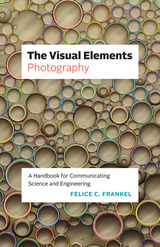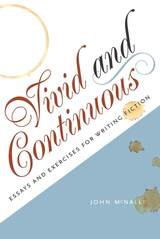226 books about Handbooks, manuals, etc and 3
start with V
226 books about Handbooks, manuals, etc and 3
226 books about Handbooks, manuals, etc
3 start with V start with V
3 start with V start with V

The Visual Elements—Design
A Handbook for Communicating Science and Engineering
Felice C. Frankel
University of Chicago Press, 2024
With insights and examples from designers at publications from Nature to the New York Times, an essential guide to creating figures and presentations.
In this short handbook, award-winning science communicator Felice C. Frankel offers a quick guide for scientists and engineers who want to share—and better understand—their research by designing compelling graphics for journal submissions, grant applications, presentations, and posters. Like all the books in the Visual Elements series, this handbook is also a training tool for researchers. Distilling her celebrated books and courses to the essentials, Frankel shows scientists and engineers, from students to primary investigators, the importance of thinking visually. This crucial volume in the Visual Elements series offers a wealth of engaging design examples. Case studies and advice from designers at prestigious publications and researchers’ own before-and-after examples show how even the smallest changes—to color, type, composition, and layering—can greatly improve communication. Ideal for researchers who want a foothold for presenting and preparing their work for everything from conferences to publications, the book explains the steps for creating a concise and communicative graphic to highlight the most important aspects of research—and to clarify researchers’ own thinking. The resulting book is an essential element of any scientist’s, engineer’s, or designer’s library.
In this short handbook, award-winning science communicator Felice C. Frankel offers a quick guide for scientists and engineers who want to share—and better understand—their research by designing compelling graphics for journal submissions, grant applications, presentations, and posters. Like all the books in the Visual Elements series, this handbook is also a training tool for researchers. Distilling her celebrated books and courses to the essentials, Frankel shows scientists and engineers, from students to primary investigators, the importance of thinking visually. This crucial volume in the Visual Elements series offers a wealth of engaging design examples. Case studies and advice from designers at prestigious publications and researchers’ own before-and-after examples show how even the smallest changes—to color, type, composition, and layering—can greatly improve communication. Ideal for researchers who want a foothold for presenting and preparing their work for everything from conferences to publications, the book explains the steps for creating a concise and communicative graphic to highlight the most important aspects of research—and to clarify researchers’ own thinking. The resulting book is an essential element of any scientist’s, engineer’s, or designer’s library.
[more]

The Visual Elements—Photography
A Handbook for Communicating Science and Engineering
Felice C. Frankel
University of Chicago Press, 2023
For novice or pro, primary investigator or postdoc, the essentials for photographing science and technology for journals, grant applications, and public understanding.
Award-winning photographer Felice C. Frankel, whose work has graced the covers of Science, Nature,and Scientific American, among other publications, offers a quick guide for scientists and engineers who want to communicate—and better understand—their research by creating compelling photographs. Like all the books in the Visual Elements series, this short guide uses engaging examples to train researchers to learn visual communication. Distilling her celebrated books and courses to the essentials, Frankel shows scientists and engineers the importance of thinking visually. When she creates stunning images of scientific phenomena, she is not only interested in helping researchers to convey understanding to others in their research community or to gain media attention, but also in making these experts themselves “look longer” to understand more fully. Ideal for researchers who want a foothold for presenting and preparing their work for conferences, journal publications, and funding agencies, the book explains four tools that all readers can use—a phone, a camera, a scanner, and a microscope—and then offers important advice on composition and image manipulation ethics. The Visual Elements—Photography is an essential element in any scientist’s, engineer’s, or photographer’s library.
Award-winning photographer Felice C. Frankel, whose work has graced the covers of Science, Nature,and Scientific American, among other publications, offers a quick guide for scientists and engineers who want to communicate—and better understand—their research by creating compelling photographs. Like all the books in the Visual Elements series, this short guide uses engaging examples to train researchers to learn visual communication. Distilling her celebrated books and courses to the essentials, Frankel shows scientists and engineers the importance of thinking visually. When she creates stunning images of scientific phenomena, she is not only interested in helping researchers to convey understanding to others in their research community or to gain media attention, but also in making these experts themselves “look longer” to understand more fully. Ideal for researchers who want a foothold for presenting and preparing their work for conferences, journal publications, and funding agencies, the book explains four tools that all readers can use—a phone, a camera, a scanner, and a microscope—and then offers important advice on composition and image manipulation ethics. The Visual Elements—Photography is an essential element in any scientist’s, engineer’s, or photographer’s library.
[more]

Vivid and Continuous
Essays and Exercises for Writing Fiction
John McNally
University of Iowa Press, 2013
Taking off from The Creative Writer’s Survival Guide, John McNally’srelentlessly blunt, bracingly cheerful, and immensely helpful map to being a writer, Vivid and Continuousis an equally blunt, cheerful, and helpful map to learning to be a writer. While acknowledging that many fine books cover such essentials of fiction writing as point of view, characterization, and setting, McNally sets out in this new book—intended as a supplement to beginning fiction-writing classes or as the sole text for upper-level or graduate courses—to solve the tricky second-tier problems that those books cover only in footnotes.
Vivid and Continuous takes its inspiration from John Gardner, whose essential truths in On Becoming a Novelist clarified McNally’s goal of communicating a “vivid and continuous dream” with his own writing. In fifteen concise, energizing chapters, he dispenses advice gained from almost thirty years of studying, writing, and teaching. How do you avoid the pitfalls inherent in the most common subjects for stories? How do you create memorable minor characters? What about managing references to pop culture without distracting your readers, revising a story to bring its subtext into focus, or exploring the twenty most common craft-related quirks that lessen immediacy for your readers? How do you keep from overdosing on similes and metaphors or relying on too many flashbacks to provide necessary backstory? How do you learn to listen when your story tries to talk to you? Finally, how can you resist “John McNally’s Sure-Fire Formula for Becoming Funnier in 30 Days”?
McNally cites many novels and short stories as examples that best illustrate the lessons he wants to impart, the writer’s life, or the writer’s craft, as well as his own favorite authors’ novels and short story collections. Exercises at the end of each chapter reinforce its point and serve as practical catalysts for new writings and directions.
Just blunt enough to get your attention but not blunt enough to crush you, challenging but not discouraging, personal but not ego-ridden, snarky but not mean, John McNally will prompt you to think more deeply about a variety of issues that will push you toward writing more meaningful, more accomplished work. [more]
READERS
Browse our collection.
PUBLISHERS
See BiblioVault's publisher services.
STUDENT SERVICES
Files for college accessibility offices.
UChicago Accessibility Resources
home | accessibility | search | about | contact us
BiblioVault ® 2001 - 2024
The University of Chicago Press









